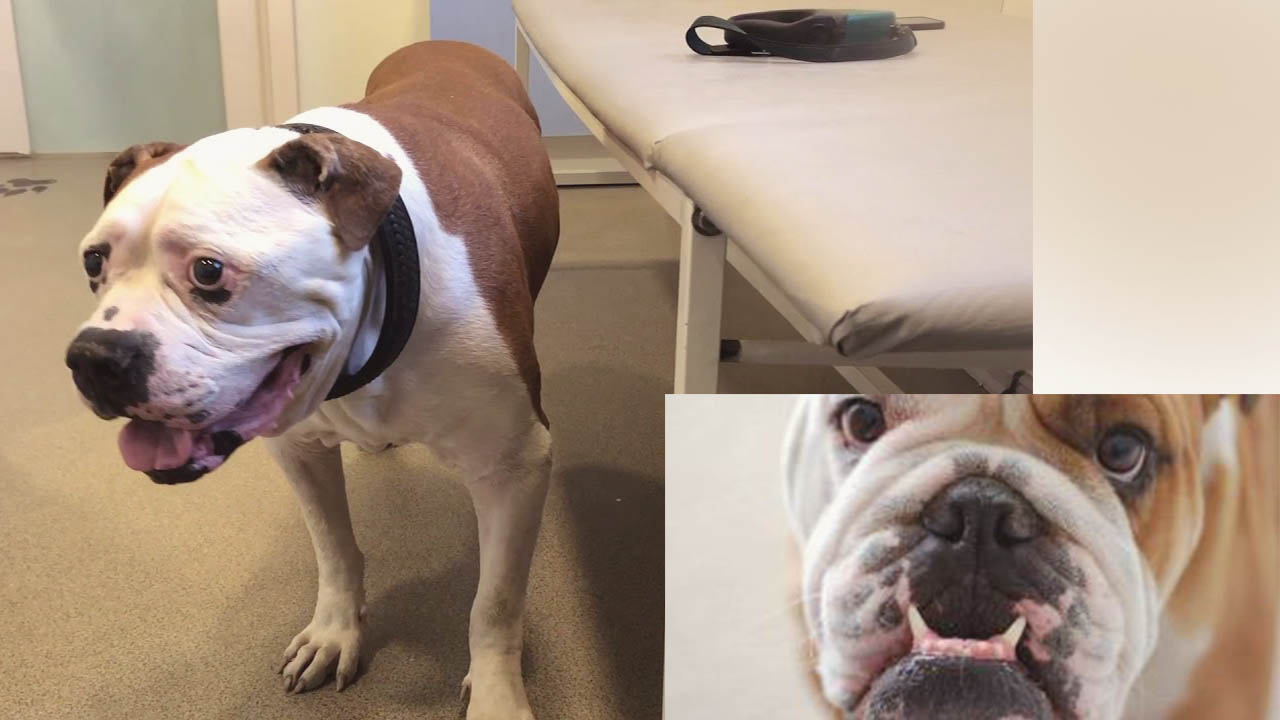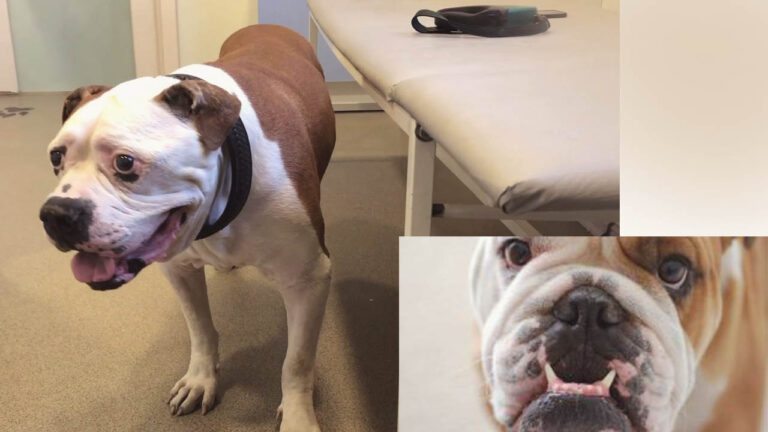Stertor is a snoring-like sound during inhalation, while stridor is a high-pitched sound during both inhalation and exhalation in dogs. Stertor is a respiratory sound characterized by snoring or snorting-like noise that occurs due to air passage through partially obstructed nasal or pharyngeal airways.
On the other hand, stridor is a higher-pitched sound that dogs produce while inhaling or exhaling, which results from the obstruction of the trachea, larynx, or bronchi. Dogs with stridor may experience difficulty breathing, coughing, or wheezing. Stridor is a severe condition than stertor and requires immediate medical attention. Therefore, understanding the difference between stridor and stertor is important to identify and manage any respiratory issues in dogs.

What Is Stertor?
Stertor Vs Stridor Dog: What Is Stertor?
Dogs are our loyal companions and we would do anything to keep them healthy. However, sometimes they can experience certain health issues that we might not understand. One of these health issues is stertor. Stertor is a breathing noise that dogs make when they inhale and exhale through their nostrils.
It is a common condition that can affect dogs of all ages and breeds.
Definition Of Stertor
Stertor is a respiratory condition that affects dogs, causing a snoring-like noise when they inhale and exhale through their nostrils. It occurs when the airflow through the nasal passages is partially blocked. This partial blockage happens when respiratory tissues or airways are inflamed.
Causes Of Stertor
Several factors can cause stertor in dogs, including:
- Allergies: Allergic reactions in dogs can cause inflammation of the respiratory tissues, leading to stertor.
- Upper respiratory infection: Bacterial and viral infections in dogs affect the sinuses and nasal passage, causing inflammation, resulting in stertor.
- Dentition: When dogs are teething, their gums can be swollen, and the inflammation can affect their nasal passages, causing stertor.
- Age: As dogs get older, various respiratory tissues in their bodies can lose tone, causing their airways to narrow, leading to stertor.
Symptoms Of Stertor
The following symptoms can indicate that your dog is suffering from stertor:
- Loud and coarse snoring-like sound when breathing through nostrils.
- Wheezing or snorting when breathing.
- Nasal discharge, either clear or with pus.
- Difficulty breathing, making your dog’s breathing laboured.
- Dry or cracked nostrils.
Treatment Options For Stertor
Treating stertor in dogs entails treating the underlying cause. Below are some effective treatment options:
- Surgery: If there is a significant obstruction in the airways, surgery can be an effective treatment option.
- Antibiotics: This treatment option is used to treat bacterial infections that are causing stertor.
- Anti-inflammatory drugs: Inflammation in respiratory tissues can be reduced using anti-inflammatory drugs.
- Allergy medications: Medications for allergies can help treat stertor caused by allergies.
- Home remedies: A warm compress can be used to open up blocked airways, while regular cleaning of the dog’s nasal passage can help rid it of excessive mucus.
With proper treatment and monitoring, stertor can be treated and your dog can breathe easier. However, if your dog shows any severe symptoms, such as difficulty breathing, it is essential that you contact a veterinarian immediately.
What Is Stridor?
Stertor Vs Stridor Dog: What Is Stridor?
If your furry little friend has been wheezing or making unusual breathing sounds, it can be alarming to say the least. Stridor is a condition in dogs that makes the breathing process difficult and noisy. It is characterized by a high-pitched, raspy sound that occurs when air flows through the narrowed or blocked airways of the respiratory system.
Definition Of Stridor
Stridor is a symptom, not a diagnosis. It refers to the sound that is produced when the air is moving through a narrowed or partially obstructed airway. The sound is usually high-pitched and can be heard during inhalation, exhalation, or both.
Causes Of Stridor
Stridor can be caused by a number of underlying conditions, including:
- Congenital abnormalities in the respiratory tract
- Allergies or inflammation in the airways
- Respiratory tract infections
- Tumors or masses in the respiratory system
- Trauma to the neck or the throat
- Foreign objects in the airways
Symptoms Of Stridor
The most common symptom of stridor in dogs is noisy breathing. In some cases, the sound may be more noticeable during exercise or excitement. Other symptoms can include:
- Coughing or gagging
- Difficulty breathing or rapid breathing
- Bluish or discolored gums
- Flared nostrils
- Restlessness or anxiety
Treatment Options For Stridor
Treatment for stridor varies depending on the underlying cause. Some treatment options include:
- Medications to reduce inflammation and manage symptoms
- Surgery to remove tumors or correct congenital abnormalities
- Oxygen therapy to improve breathing
- Clean air environment for allergic dogs
If you hear your dog producing unusual breathing sounds or notice any of the above symptoms, it is essential to seek veterinary treatment promptly. Early intervention can improve the prognosis for a variety of respiratory issues.
Difference Between Stertor And Stridor
Stertor Vs Stridor Dog: The Key Differences
Dogs make different noises when they breathe, and these noises can be concerning for pet owners. Knowing the difference between the sounds is beneficial in determining when a dog must receive medical attention. Two common sounds dogs make are stertor and stridor.
Understanding the distinctions between these sounds can significantly improve your dog’s health.
Distinctive Features Of Stertor And Stridor
Stertor and stridor both indicate abnormal breathing patterns. However, these two sounds result from different factors. In this section, let’s look at the distinctive features of stertor and stridor.
Stertor
Here are the key features of stertor:
- Stertor is a snoring-like sound that a dog produces during inhalation.
- It is an indication that there is resistance to airflow in the upper respiratory system
- Stertor is common among flat-faced dogs.
Stridor
Here are the key features of stridor:
- Stridor is a high-pitched whistling sound that a dog produces during inhalation or exhalation.
- It occurs due to the narrowing of the trachea or larynx.
- Stridor is common among dogs with swelling in their voice box region.
Differentiating Symptoms Of Stertor And Stridor
When a pet owner suspects abnormal breathing sounds, then recognising stertor and stridor’s differentiating symptoms is beneficial to provide timely medical intervention. Let’s look at the symptoms indicative of stertor and stridor.
Stertor
Here are the key symptoms of stertor:
- It occurs mainly when a dog is deeply asleep or relaxed.
- A dog may exhibit signs of fatigue, lack of consciousness, or disorientation.
- The sound is usually less acute than stridor.
Stridor
Here are the key symptoms of stridor:
- A dog makes a shrill, wheezing sound while inhaling or exhaling, indicating difficulty breathing
- The sound is continuous and louder than stertor.
- A dog may open its mouth while inhaling or exhaling to facilitate adequate air intake.
Knowing the difference between stertor and stridor can be vital in helping your pet lead a long, healthy, and happy life. If you’re concerned about your dog’s breathing sounds, it’s crucial to seek medical attention immediately to prevent complications.
Prevention And Management
Stertor And Stridor Dog: Prevention And Management
Taking care of dogs with stertor and stridor:
Dogs can experience heavy breathing sounds due to an array of reasons, including upper respiratory tract problems that result in either stertor or stridor. Stertor is a snorting, throaty breathing sound, while stridor is a high-pitched honking sound. Here are the ways to take care of dogs suffering from these issues:
Things To Avoid:
Certain things can worsen the condition of a dog’s stertor and stridor. As an owner, you should avoid the following to ensure your dog’s comfort:
- Smoking around dogs
- Dust, debris, and other pollutants
- Exhaust fumes
- Extreme temperatures
- Prolonged bouts of excessive barking or vocalization
Tips To Prevent Stertor And Stridor:
Preventing stertor and stridor can be a challenge, but there are several strategies you can use to reduce the likelihood of them developing:
- Keep your dog’s environment clean and free of irritants. This includes regular cleaning and dusting, vacuuming, and air filtration.
- Keep your dog’s weight in check. Obesity can exacerbate both stertor and stridor by restricting breathing.
- Make sure your dog is groomed regularly, especially if he has long hair. Hair in the nose can restrict airflow.
- Schedule regular vet check-ups. Your vet can identify any early signs of stertor or stridor and advise you on how to manage them.
Home Remedies:
While stertor and stridor can be distressing, there are several home remedies that can help soothe your dog and alleviate his symptoms:
- Use a humidifier. Adding moisture to the air can help your dog breathe more easily.
- Elevate your dog’s sleeping area. This helps to open up air passages and reduce snoring.
- Change your dog’s diet. Certain foods, such as fatty meats, can increase inflammation and worsen stertor and stridor.
- Use essential oils. Eucalyptus, tea tree, and lavender essential oils can help reduce inflammation and help your dog breathe more easily.
Taking care of dogs suffering from stertor and stridor can be a daunting task, but with the right care, it can be managed. Follow these simple steps, and you’re sure to help your furry companion breathe easy.
FAQ On Stertor Vs Stridor Dog
What Is Stridor In Dogs?
Stridor is a high-pitched, wheezing sound that occurs while inhaling, indicating the narrowing of the upper airways. In dogs, it is often associated with respiratory distress and may be life-threatening if left untreated.
What Is Stertor In Dogs?
Stertor is a snoring or snuffling sound that occurs while breathing, indicating the narrowing of the lower airways, including the trachea and bronchi. Unlike stridor, it is typically not a medical emergency.
What Causes Stridor In Dogs?
Stridor can occur due to various reasons ranging from foreign objects or tumors blocking the airways to infections, inflammation, or trauma. Aging-related changes can also contribute to the development of stridor in dogs.
What Causes Stertor In Dogs?
Stertor can be caused by numerous reasons, including allergies, infections, underlying medical conditions, weight-related breathing difficulties, or even a relaxed upper airway during sleep.
How To Treat Stridor In Dogs?
Treatment for stridor in dogs depends on the underlying cause. In severe cases, it may require hospitalization, oxygen therapy, or even surgery to remove airway blockages. In mild cases, medications and lifestyle changes can often ease the symptoms.
How To Treat Stertors In Dogs?
Stertor in dogs can be managed by simply changing their sleeping position, reducing their weight, or treating the underlying medical conditions. In some cases, your veterinarian may recommend medications to reduce inflammation and swelling in the airways.
Conclusion
To sum up, identifying whether your dog is experiencing stertor or stridor is crucial in managing their health. Stertor is a harmless and natural sound that dogs make during sleep or rest, whereas stridor is a concerning symptom that indicates a respiratory obstruction or abnormality.
As a dog owner, it’s essential to recognize the difference between the two, and take immediate action if your pet is experiencing stridor. Remember, dogs with underlying medical conditions are more likely to be affected by stridor than healthy ones, and early diagnosis and treatment can help in mitigating the issue.
As always, it’s advisable to seek veterinary care if you’re not sure or if your dog is experiencing stridor. Ultimately, by being aware of your dog’s breathing patterns and knowing the difference between stertor and stridor, you can ensure that your pet stays healthy and happy.



